Japanese knotweed identification - the complete guide
Read through our comprehensive Japanese knotweed identification guide below. If you are still not sure, watch our Identification video, download our Quick Digital ID Guide, or upload your photos and we’ll confirm whether it’s knotweed for FREE.
Quick facts
- Japanese knotweed is visible above ground between February and November.
- This alien invader can grow at a rate of 10cm a day in spring.
- The most distinctive part of Japanese knotweed is the shield shape leaves.
- Knotweed dies back in winter, making it harder to spot.



What's Japanese knotweed?
Japanese knotweed (Reynoutria japonica syn. Fallopia japonica & Polygonum cuspidatum) is a non-native, invasive plant that was imported to the UK in Victorian times. Originally merited for its beauty, durability, and regenerative powers, it is now widely recognised as a pest species that outcompetes native plants and causes damage in the built environment.
The images on the right show the most distinctive characteristics of the plant and will help you with Japanese knotweed identification throughout the year.
Read our in-depth Guide exploring what Japanese knotweed is, and why it is such a problem.
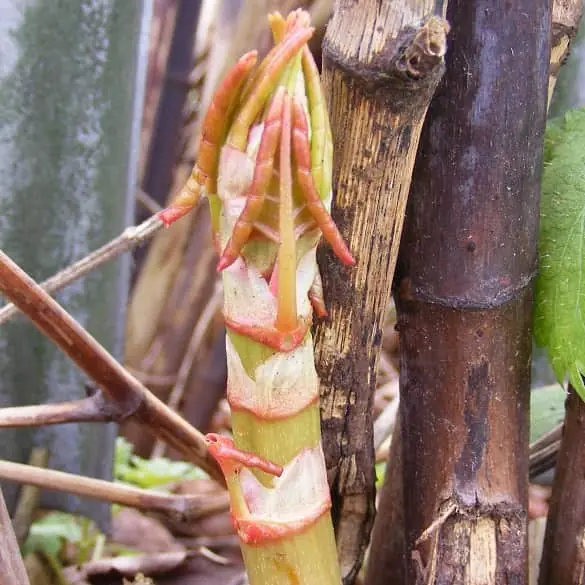
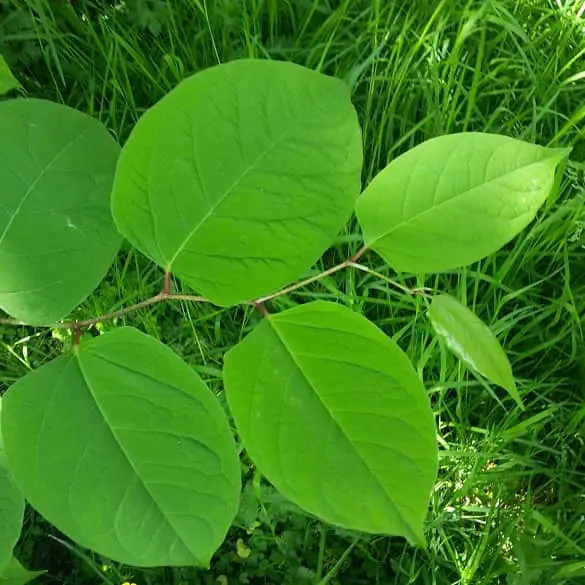
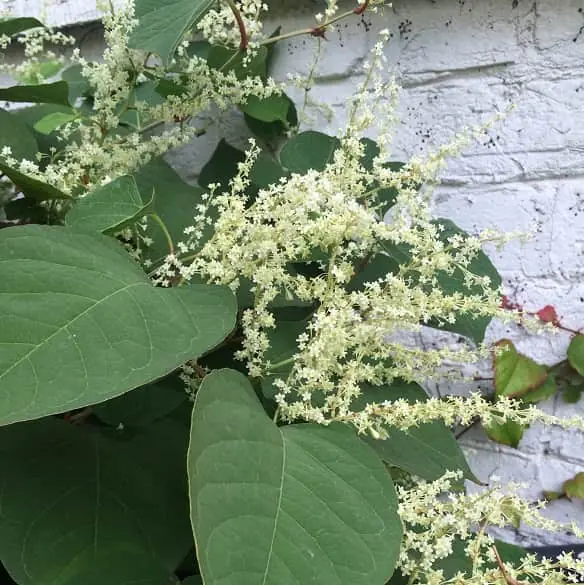
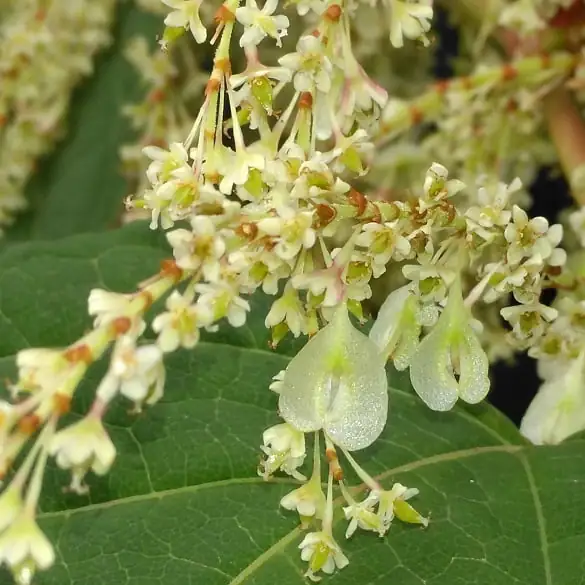
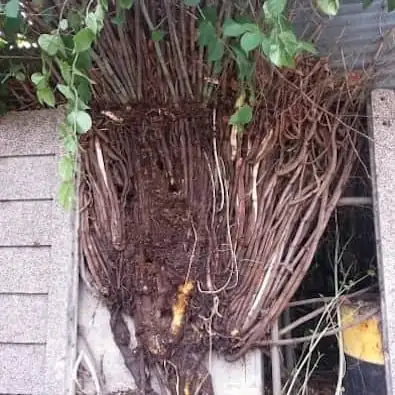
How do you identify Japanese knotweed?
The appearance of Japanese knotweed changes with the seasons, so it is important to consider the time of year when you are checking. Japanese knotweed is most easily identified during the spring and summer months.
Key traits of Japanese knotweed:
- Red shoots emerge in spring that look like asparagus.
- Leaves that are shield or shovel-shaped.
- Stems that resemble bamboo canes with purple speckles.
- Small, cream-coloured flowers developing towards the end of summer.
In the autumn, the leaves will start to go yellow and drop as winter approaches. Knotweed can grow to about two or three metres if left unattended. The stems will change to a darker brown before the plant becomes dormant in winter.
What does the start of Japanese knotweed look like?
As mature Japanese knotweed begin their growth, it can be quite alarming to watch. Thick, upright stems that look like asparagus pierce the ground and can grow 10cm in height per day until they reach their full height at the end of spring. Following this rapid growth, these stems, or canes, resemble bamboo and will usually reach 1m or more in height before any leaves or side branches start to grow. Canes emerge in clumps from a main crown in the ground.
Beware though, because the start of Japanese knotweed where it is newly imported, disturbed, or spreading out naturally from an existing area of established knotweed looks completely different. New shoots tend to be much smaller and deep red. They can also be dark green with deep red leaf edges. These plants are normally considerably smaller and open into leaf much earlier.
Similarly, the appearance of knotweed can be significantly altered when it starts to regrow from a failed herbicide treatment. We call this ” bonsai growth“.
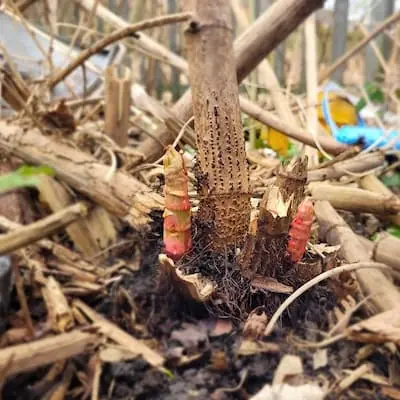
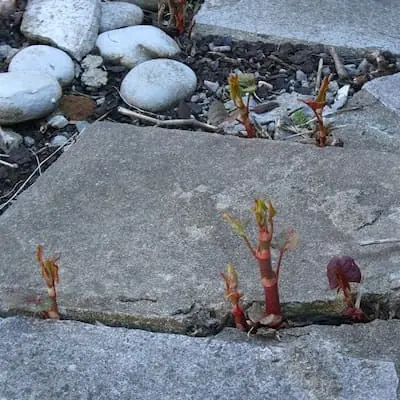
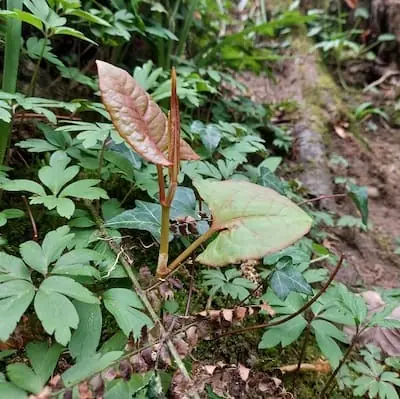
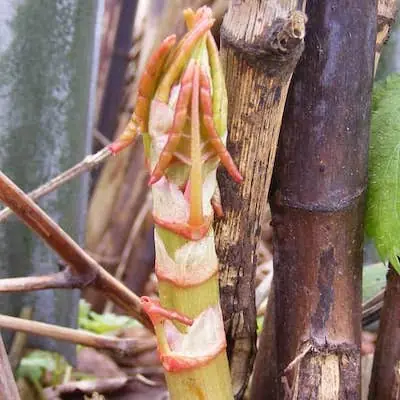
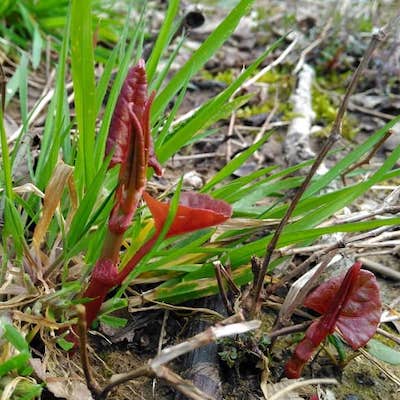
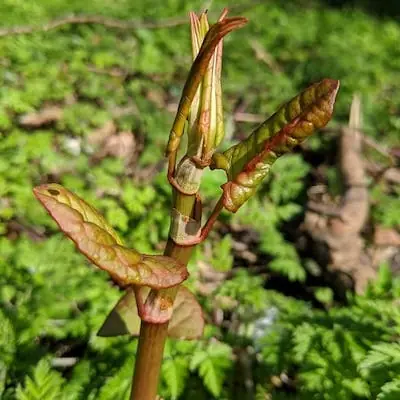
What does Japanese knotweed look like in April?
It can be difficult to recognise Japanese knotweed in the spring months of February, March, and April as this is when the plant first starts to grow. If you have an existing infestation that has been dormant over the winter, you might be able to spot the brown, bamboo-like stems sticking out of the ground.
A notable feature during these months is that the new Japanese knotweed shoots appear as asparagus-like plants. These start as reddish buds that transform into shoots and can grow at a rate of a couple of centimetres a day. They quickly outgrow surrounding plants. On warm April days, more mature plants can grow at a rate of 10cm a day.
By April, as the fleshy shoots gain height, they develop bright lime-green leaves.
What does Japanese knotweed look like in Summer?
Mature Japanese knotweed plants usually reach their maximum height of 2 – 2.5m by the end of May. Leaves unfurl into their distinct shield shape and vivid lime green colour. Canes often grow from distinct crowns in the ground and are silvery green with purple/pink speckles. As late summer progresses, the leaves become darker green, and clusters of creamy white flowers start to appear. Bees find the abundance of flowers highly attractive.
Smaller, immature areas of knotweed are unlikely to grow to more than 1m in height, but they still undergo the same changes in leaf colour and are easily identifiable by their distinctive zig-zag stem formation and shield-shaped leaves. It’s worth noting that young plants may not flower.
Key Summer Identification:
- Tall stems, reaching 2.5m in height, green with purple speckles.
- Vivid green shield-shaped leaves, on alternate stems.
- Clusters of small creamy white flowers.
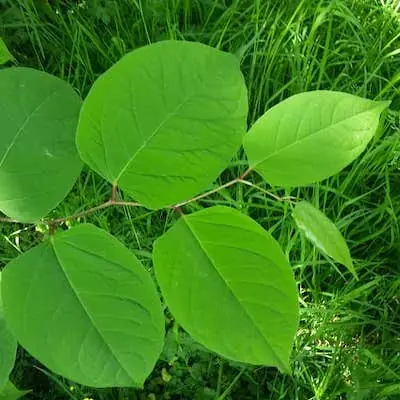
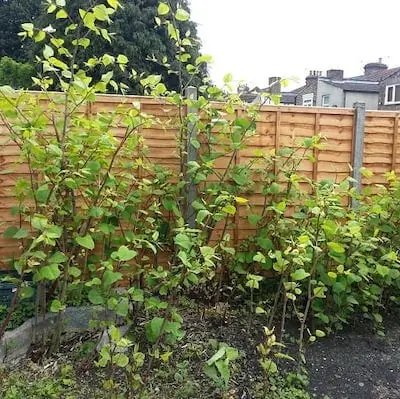
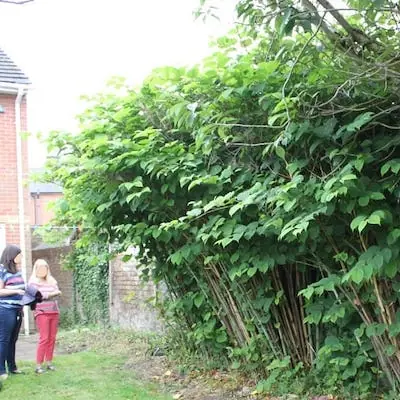
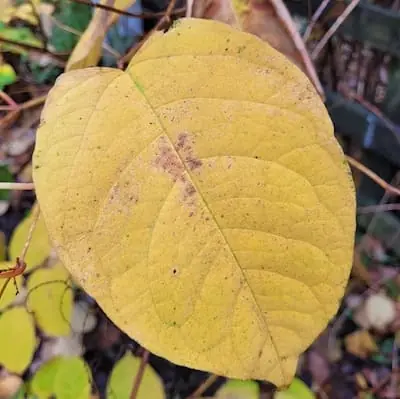
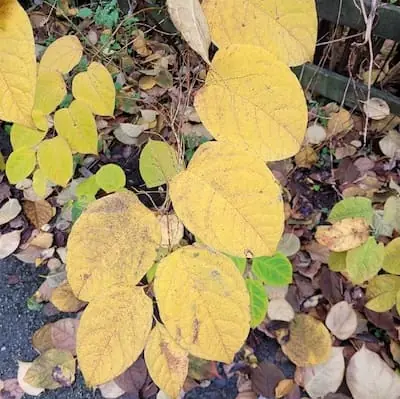
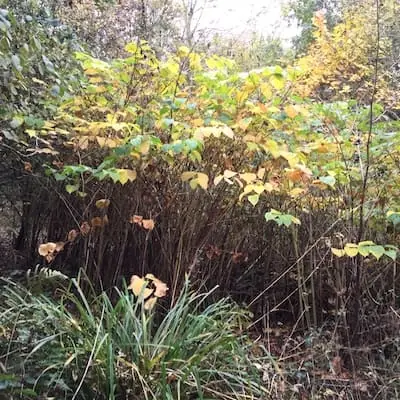
What does Knotweed look like in Autumn?
Japanese knotweed is a perennial plant, which means it dies right back come Autumn and re-emerges the following spring. Over time, as the weather gets cooler and light levels drop in October and November, Japanese knotweed leaves start to turn yellow and then eventually brown, before dropping to the ground just as a deciduous tree does. The stems (canes) of the plant also lose their fleshy green appearance, gradually turning brown and brittle. After the first few frosts, Japanese knotweed will have completely died back, leaving, brown brittle canes behind.
Key Autumn Identification:
- Yellowing leaves with brown spots.
- Clusters of old flowers, sometimes with heart-shaped seed pods visible.
- Stems begin to change from green to a rich red/brown.
How do you identify Japanese knotweed in Winter?
In spring and summer months, identifying Japanese knotweed becomes relatively easy once you know its characteristics. Surveyors are, however, expected to identify knotweed throughout all seasons, even though spotting this problem weed becomes trickier in winter.
Things to look out for are:
- Brown, brittle canes left standing.
- Distinctive crowns in the ground.
- Scorched areas of grass and bare patches of earth.
- Smaller plants with distinctive zig-zag stem distribution.
A growing number of surveyors are being sued for professional negligence as a result of missing Japanese knotweed during surveys. We’re here to help make sure knotweed can be correctly identified whatever the time of year.
If you are unsure, we offer a free Japanese knotweed identification service. Email your photos to expert@environetuk.com and we’ll tell you if Japanese knotweed is present.
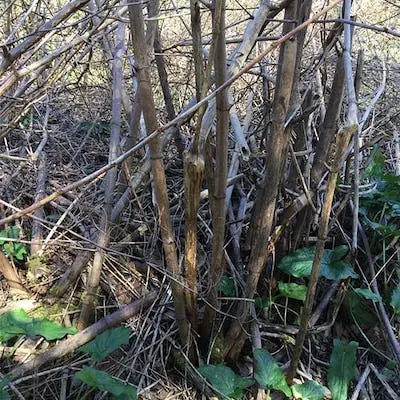
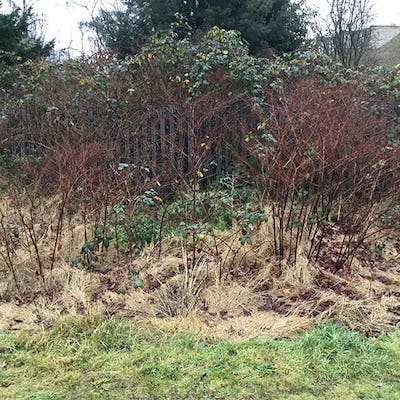
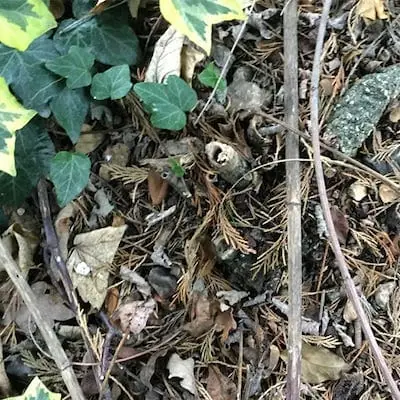
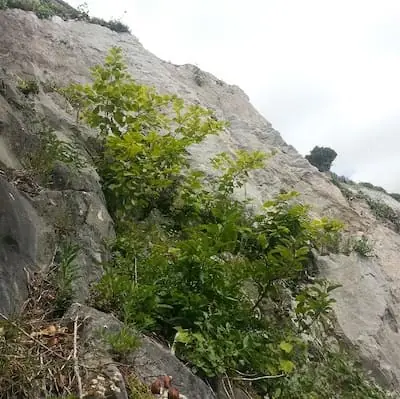
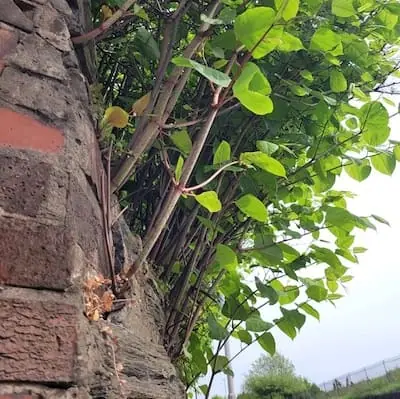
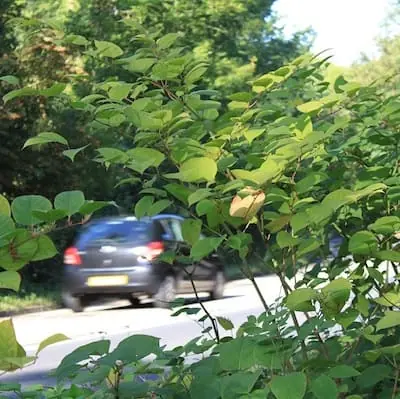
Where does Japanese knotweed grow?
Japanese knotweed can and will grow pretty much anywhere. It is an amazingly resilient plant that can tolerate extremes in temperature, moisture, and pH. The fast-growing habit of Japanese knotweed, combined with its energy-packed rhizome system, gives it a competitive advantage over many other plants, allowing it to establish growth in places where others would stand no chance. Over the last 25 years, we have identified Japanese knotweed growing in all sorts of places, including on beaches, out of riverbeds, from cracks in cliffs, and even out of chimneys!
Since its introduction in the 1840s, Japanese knotweed has spread to every corner of the UK. Some areas are affected more than others, which is why we launched Exposed™, the Japanese knotweed Heatmap, to record and track the spread of the species over time.
Japanese knotweed is most commonly found in the following places:
- Residential gardens.
- Roadside verges.
- Railway embankments.
- Riverbanks.
How does Japanese knotweed grow?
In its native range, Japanese knotweed spreads both by seed and vegetatively, but in the UK the plants are all female. This means that although seeds are often produced, they are infertile and cannot produce new plants. All plants in the UK are therefore a result of growth from root and stem fragments.
Japanese knotweed can however pollinate Giant knotweed – which results in fertile seeds of Bohemian knotweed – a growing problem in the UK.
Knotweed uses its dense rhizome, packed with water and nutrients to supply the energy it needs for new growth. Once shoots emerge, put on leaves, and start to photosynthesise, the knotweed can then use that energy to grow more creeping rhizomes that allow the plant to spread.
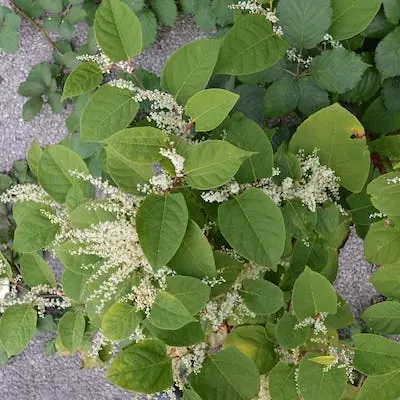

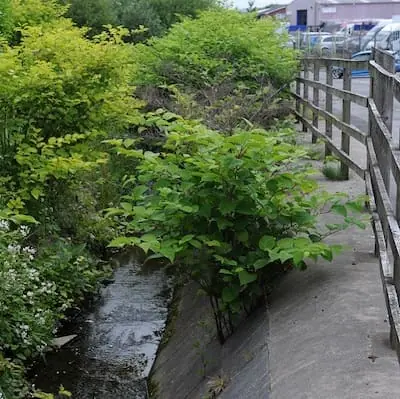
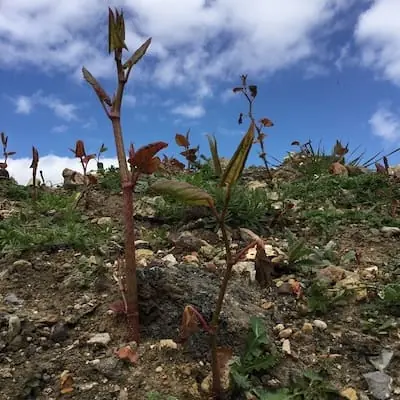
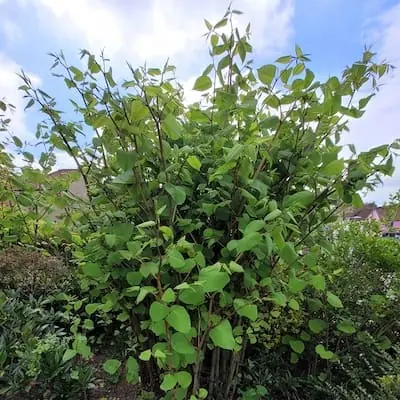
When is the best time to spot Japanese knotweed?
Japanese knotweed is most easily spotted in late spring and summer. There are not many other species that emerge from the ground in spring at such an impressive rate, meaning Japanese knotweed shoots often stick out like a sore thumb compared to most slower-growing native and ornamental plants.
Japanese knotweed is at its most distinct in high summer, where the tall attractive canes draw your eye. The nature of Japanese knotweed means it spreads into large stands, outcompeting all other plants. When you know that Japanese knotweed is present, you can often identify it through aerial and satellite imagery!
What can be mistaken for Japanese knotweed?
Plants that people often mistake for Japanese knotweed include:
- Bindweed.
- Himalayan balsam.
- Russian vine.
- Broadleaf dock.
- Peony.
- Lilac and other woody shrubs like Dogwood.
Japanese knotweed can cause a great deal of damage to properties. Identifying the plant is not always simple and it’s easy to get confused.
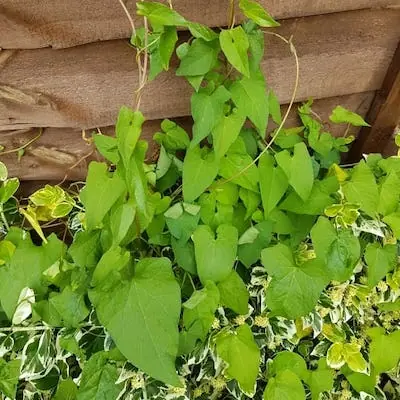
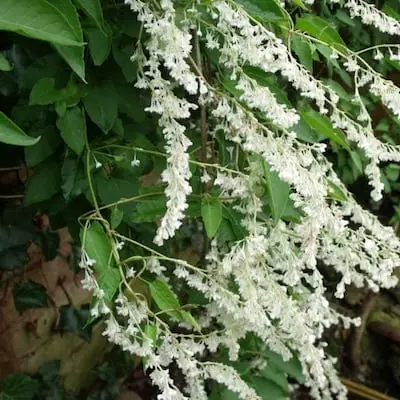
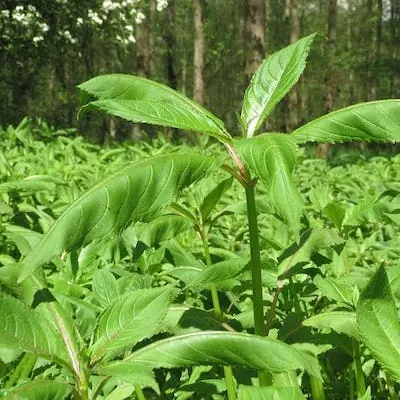
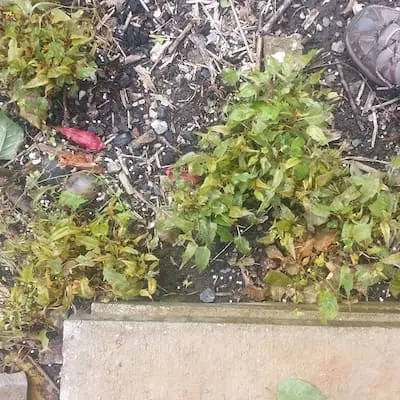
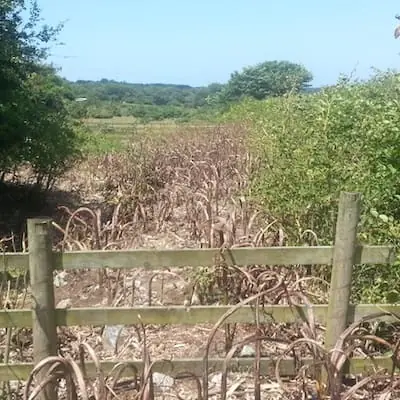
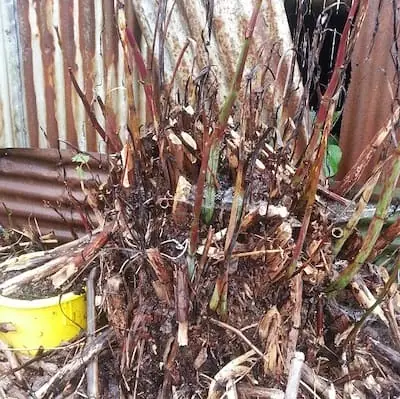
What does Japanese knotweed look like when it's been treated?
It can take many years before Japanese knotweed gives up the fight to grow when you are tackling it with herbicide treatment alone. Regrowth from glyphosate-based treatments often takes the form of “bonsai” growth.
Completely different in appearance to a healthy plant, bonsai knotweed is characterised by tiny red or green pointy leaves and straggly deformed stems. It often grows in small clumps, low to the ground, and would be easy to overlook as Japanese knotweed.
Bonsai knotweed often isn’t large enough to take in the required volume of herbicide to kill the rhizome beneath the ground, therefore the best course of treatment is to excavate it to ensure there is no trace of viable rhizome remaining in the ground. To find out more about excavation please visit our Resi Dig-Out™ page.
What Japanese knotweed hybrids are there?
There are lots of plants in the knotweed family, many look similar to Japanese knotweed, but are much less invasive and therefore perfectly OK to grow. There are however some varieties, including hybrids of Japanese knotweed that are also listed under the Wildlife and Countryside Act 1981, which should be treated in the same way as Japanese knotweed. These are:
- Giant knotweed (Fallopia Sachalinensis)
- Bohemian knotweed (Fallopia x Bohemica syn. Reynoutria x Bohemica)
- Dwarf knotweed (Reynoutria Japonica var. Compacta)
Our in-depth guide to Japanese knotweed explains the differences between the species along with how to identify them.
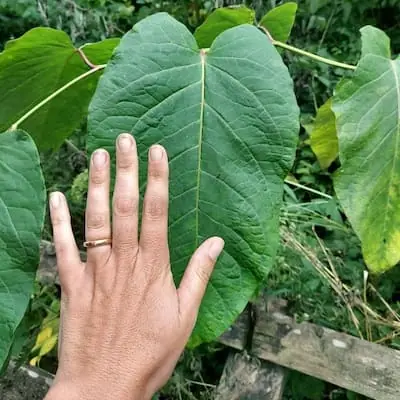
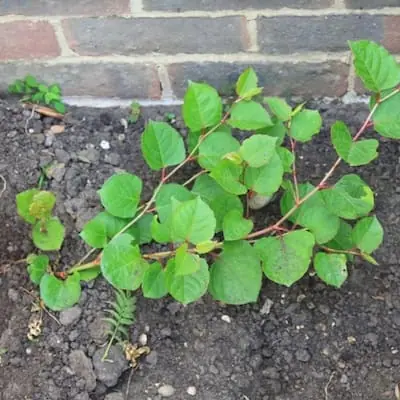
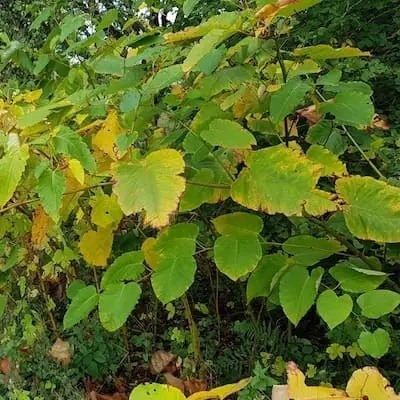
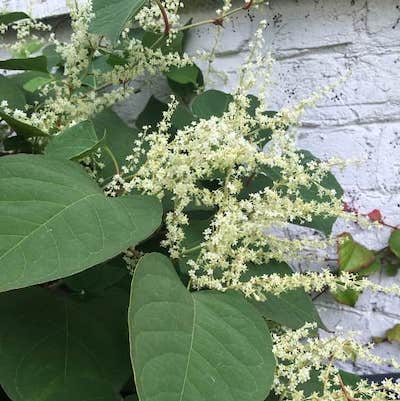
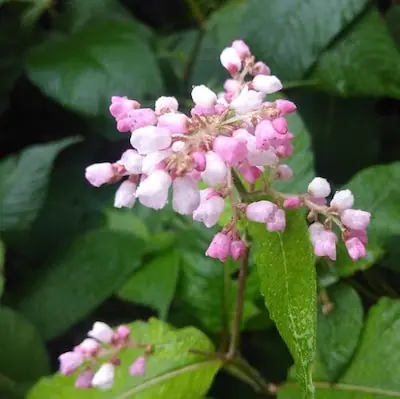
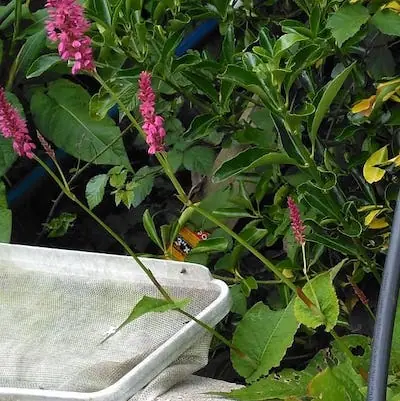
Does Japanese knotweed have pink flowers?
Some species, such as dwarf Japanese knotweed, can have pink flowers, but these are less invasive, and their incidence in the UK is lower. The Japanese knotweed we find in our gardens and on commercial properties has small clusters of creamy white flowers. These flowers generally appear towards the end of summer and into autumn, just before the plant becomes dormant and ‘closes down’ for the winter.
Identifying Japanese knotweed correctly can be challenging if you don’t have experience with it. If you discover Japanese knotweed on your property, it’s important to hire a professional team to handle its removal.
They will be able to use a combination of digging and chemical control to ensure the plant doesn’t return or cause any damage to your property.
Does Japanese knotweed have red stems?
At certain stages of its lifecycle, Japanese knotweed will have red or reddish-brown stems that look similar to bamboo. Even when it is first growing and shoots are just emerging, you will be able to see a red/purple tinge in the asparagus-like tips.
As the spring fades and we move into summer, the stems of the Japanese knotweed will become thicker and start to resemble bamboo. They usually turn pale green and develop little pink/purple speckles on the surface of the stem, losing their red characteristics.
In Autumn, you’ll see the leaves begin to yellow. The stems will switch from a reddish-brown to a deeper hue of brown as the plant prepares for the dormancy of winter.
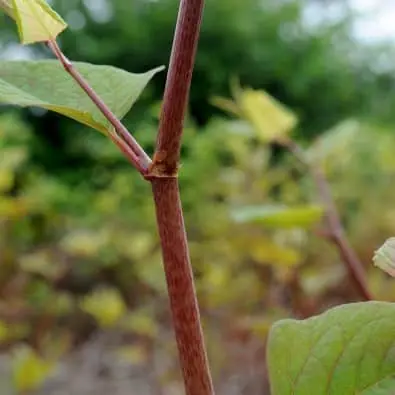
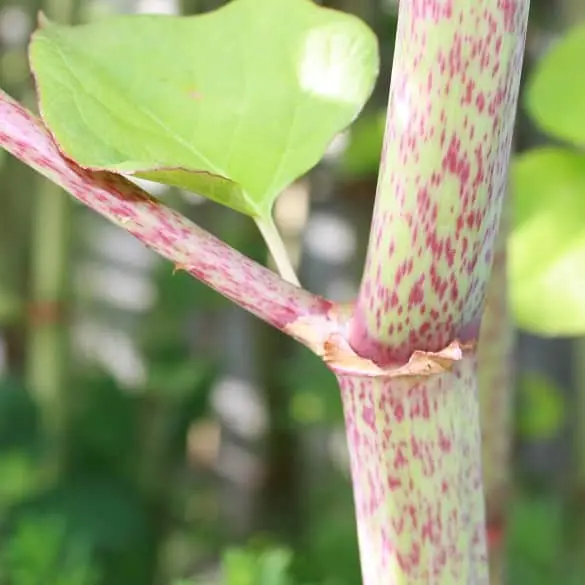
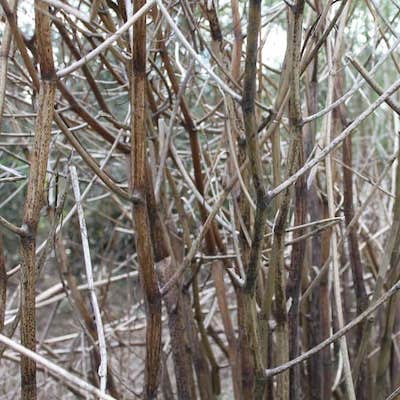
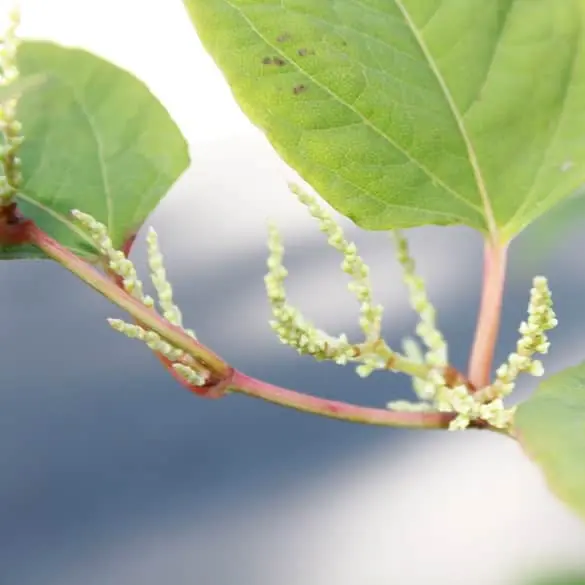
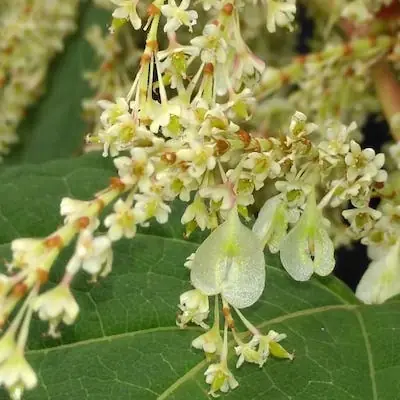

What do the flowers of Japanese knotweed look like?
Japanese knotweed flowers are fairly distinctive. They form in creamy clusters and are small in size, appearing during the late summer and early autumn. Identifying the flowers is important but it usually means that the plant has established itself quite strongly and may be difficult to remove.
Other, less prevalent types such as dwarf Japanese knotweed have pinkish leaves but these are not so invasive in the UK. Himalayan knotweed can have white or pale pink flowers.
Most people have trouble identifying whether they have Japanese knotweed at all. That’s why it’s a good idea to have it checked by a specialist.
Ideally, you want to catch the plant in its early development in the spring or the beginning of summer. Waiting too long, particularly until the Japanese knotweed flowers appear in late summer, can mean that you are more prone to property damage.
What is the difference between Bindweed and Japanese knotweed?
Bindweed and Japanese knotweed can often be mistaken for each other. Both have large, heart-shaped leaves and can grow quickly, getting out of control in a short time. The main difference between the two, however, is that bindweed is a climbing plant and will tend to wrap around garden structures or grow up the wall.
Japanese knotweed is a freestanding plant and doesn’t need any support. Both plants start to take hold in the springtime and can appear even more similar at this stage, although the shoots for Japanese knotweed have a red/purple colour and resemble asparagus tips.
The other way to differentiate the two is the flowers. Bindweed has large white trumpet flowers while knotweed has clusters of small creamy flowers. Knotweed flowers appear towards the end of summer and autumn compared to late spring-early summer for bindweed.
Both plants can be a nuisance but Japanese knotweed is by far the most invasive and likely to cause property damage.
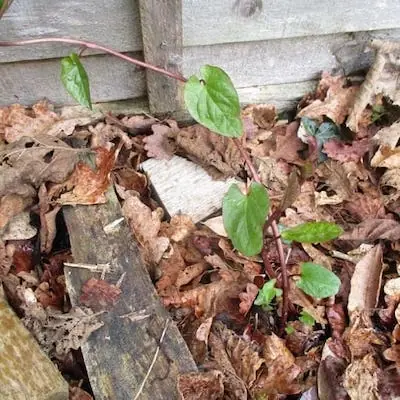
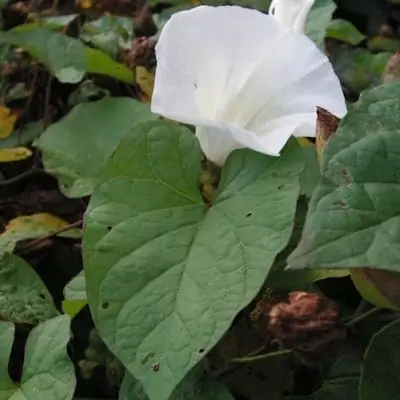
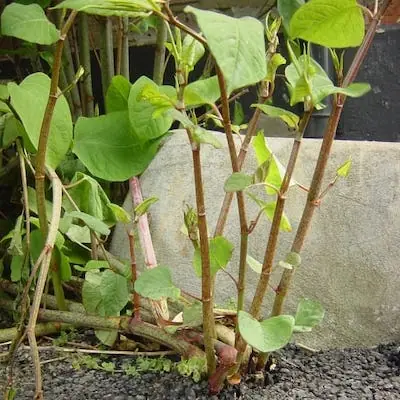
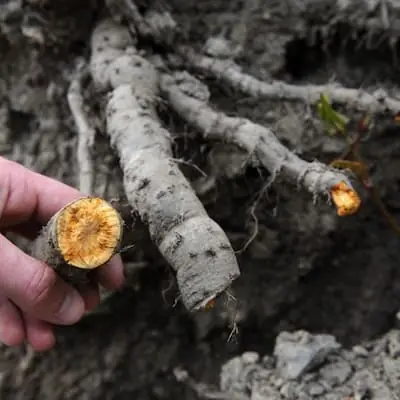
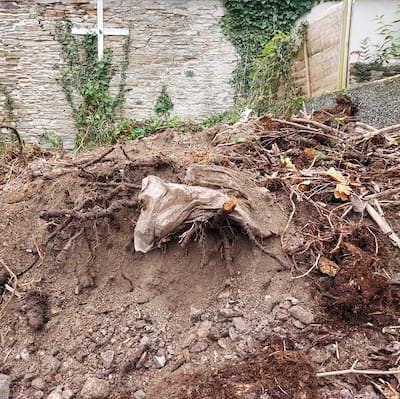
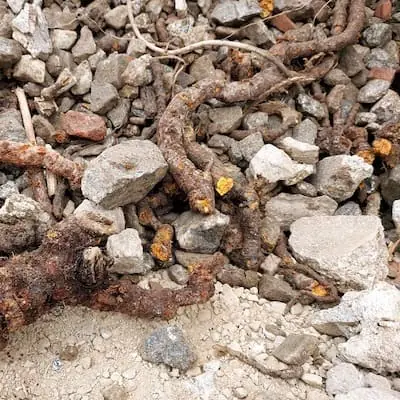
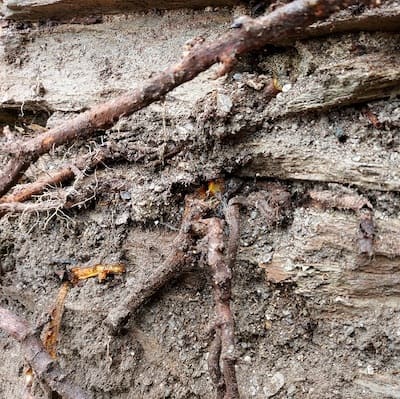
What does a Japanese knotweed rhizome/root look like?
Japanese knotweed rhizome is one of the most distinctive parts of the plant. The rhizome system is made up of long lengths of dark brown, knobbly material, that, when snapped in two, reveals a bright orange centre – much like a carrot. Rhizome diameter can vary from a shoelace to a forearm and has an incredible ability to mould itself to the shape of any obstacle in its path. The rhizomes spread laterally out from the main plant crown, often up to 2 metres in all directions. New shoots emerge from the rhizome system each year, establishing new satellite crowns over time.
The dark brown rhizome has an incredible ability to regenerate, with some lab samples as small as 0.06g establishing new plants! Of course, in nature, fragments that small are unlikely to survive, but Japanese knotweed will readily grow new plants from fragments of around 1-2cm in size. This ability to regenerate is what has enabled the plant to spread so far across the UK, and in turn, what makes it so difficult to get rid of!
How deep do Japanese knotweed roots go?
Japanese knotweed spreads from its highly regenerative underground rhizome system. Whilst the visible extent of above-ground growth is a useful indicator, it does not reflect the full magnitude of the rhizome system. The roots of Japanese knotweed are a huge problem and can grow as deep as 3 metres (although most commonly 1.5-2m) which is what makes it so hard to get rid of.
Above the ground, the plant is equally fast-growing and is quickly able to reach heights of two or three metres. A mature, established plant will grow as much as 10cm in height per day and can quickly get out of control. While the above-ground infestation is fairly easy to get rid of, it’s the roots underground that cause the biggest problem.
They can grow too deep for most normal gardening and digging practices which is why it’s important to instruct a specialist to deal with the problem. Even one rhizome remaining in the ground means that the plant will start to grow again and if left, will re-establish itself.
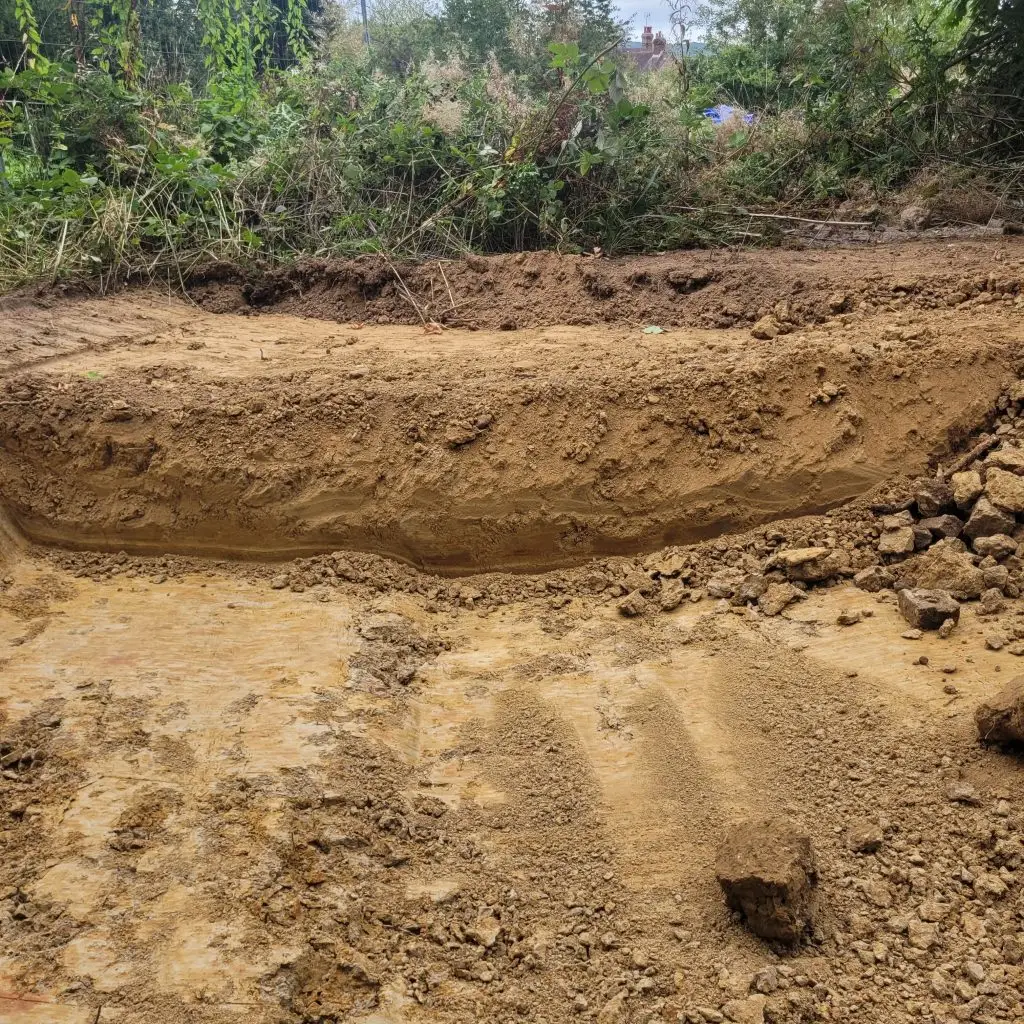
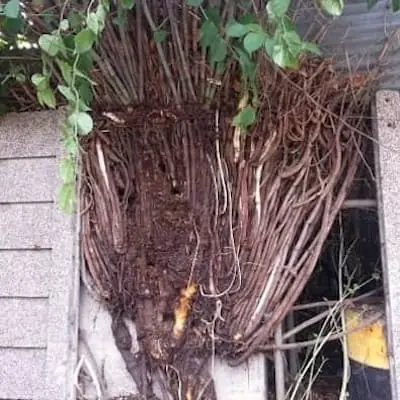
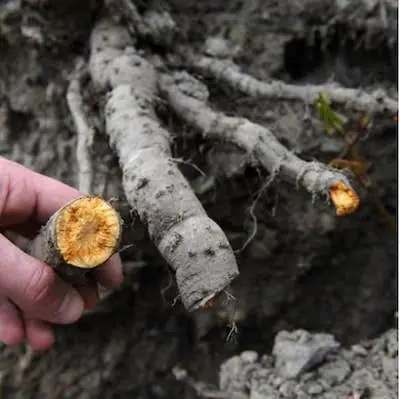
Quick Links
Start fixing your invasive plant problem today by requesting a survey
Request a survey
Rest assured, where invasive species are identified at an early stage and tackled correctly, problems can usually be avoided. Our specialist consultants complete thorough surveys to identify the extent of the problem. Our plans aren’t one-size-fits-all; they’re customised to tackle the invasive species at your property effectively, taking account of all of your requirements.
What our clients say
Reviews
What our clients say
Reviews
Ali Hamaad
“I used Environet following a recommendation to help with invasive Japanese Knotweed in my garden. Very professional, responsive and managed to co-ordinate with other contractors working on my property to remove the knotweed.”
Bernadette Spencer
“Richard was able to book us an assessment visit very quickly regarding the encroachment of evasive running bamboo in our garden .. Will completed the assessment visit,we found him to be very professional, but also friendly and easy to talk to. “
Phil Smith
“This is a very professional operation; always just on the end of the phone. The whole team seemed to know exactly what was going on with the job. (and my neighbours were very happy too.)”
Kim
“I’d just like to take the time to commend the team I have spoken to already, in particular Rachel and Suzie – they have been so friendly, reassuring and informative which has really eased the stress around this situation. Thank you all for your time. .”
L Schjolden
“I would like to commend your man Ed, who was in charge of the works at our property. He was a pleasure to deal with — punctual, polite, professional, responsible. He always kept me up to date with the progress of the works and made sure there was as little disruption to our lives as possible.”
GET IN TOUCH
Contact us
Our team of experts is available between 9am and 5:30pm, Monday to Friday to answer your enquiries and advise you on the next steps
Want a survey?
If you already know you have an invasive plant problem, you can request a survey online in less than two minutes by providing a few brief details. A member of the team will swiftly come back to you with further information and our availability.
Need quick plant identification?
Simply upload a few images of your problem plant to our identification form and one of our invasive plant experts will take a look and let you know, free of charge what you are dealing with. We’ll also be there to help with next steps where necessary.

